USB 3.0 Flash Drive Roundup
by Zach Throckmorton on July 29, 2011 11:15 AM EST- Posted in
- Storage
- Kingston
- USB 3.0
- Patriot
- Gadgets
- ADATA
- Super Talent
- Flash Drive
- Mushkin
Iometer sequential write performance benchmarks
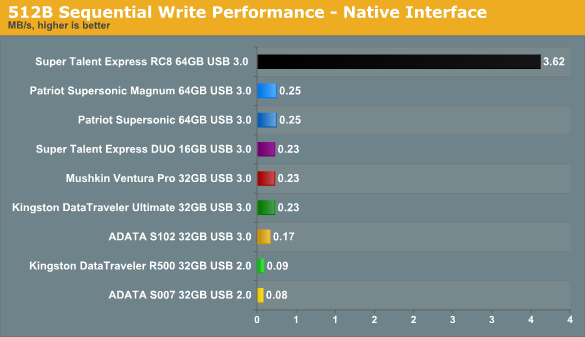
The Super Talent Express RC8 flash drive dominates the field in sequential diminutive file writes. Notice, however, the rest of the USB 3.0 drives already pulling relatively far ahead of the USB 2.0 drives.
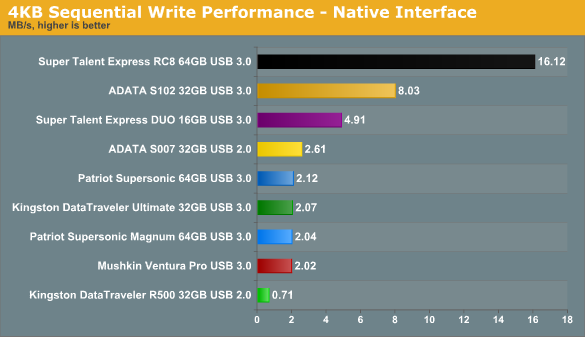
The RC8 continues its domination, though the ADATA S102 starts to pull away from the pack as well.
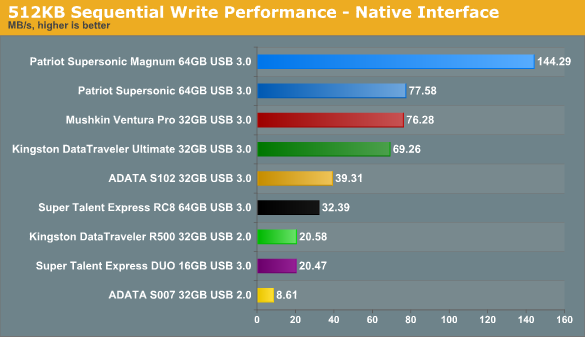
Once we hit file sizes of 512KB and higher, the field changes dramatically. The Patriot Supersonic Magnum now leads by a nearly 100% margin. Note USB 2.0 Kingston R500 edges the USB 3.0 Super Talent Express DUO in this benchmark.
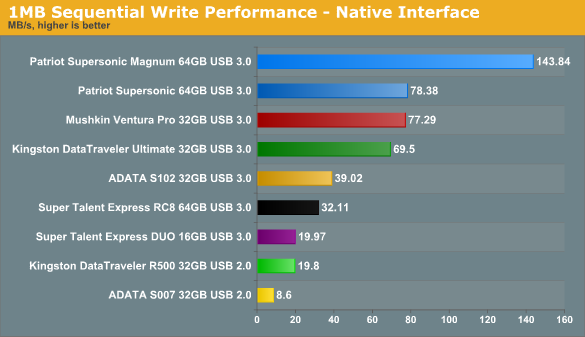
We see a very similar pattern with 1MB file sizes compared to 512KB file sizes, though the USB 3.0 Super Talent Express DUO now leads the USB 2.0 Kingston R500.
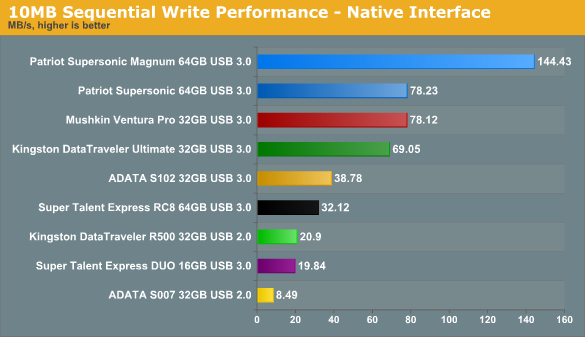
The performance hierarchy, at least in terms of sequential file writes as measured by Iometer, appears to have coalesced.
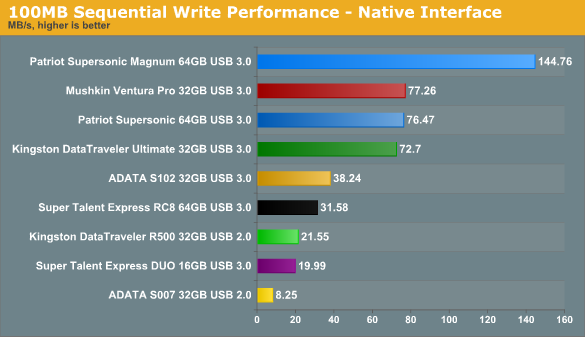
This pattern remains consistent as file sizes approach 1GB, the upper limit of Iometer's file size testing range.
You can see from these write benchmarks that USB 3.0 mitigates the storage flash drive's main weakness: slow file writes. Reading from a flash drive is almost always substantially faster than writing to it. Hopefully these dramatically faster write benchmarks translate to dramatically faster writes in real-world usage. But first, the read benchmarks, on the next page.










42 Comments
View All Comments
coyote2 - Saturday, August 6, 2011 - link
Are you talking about 6GB/s eSATA III?USB3 is so much faster than the last eSATA, I'd be surprised to hear it's "protocol overhead" could make it perform slower.
theangryintern - Friday, July 29, 2011 - link
I have the ADATA S102, got it a few months ago. So far I've been very happy with it. At home where I have a USB 3.0 controller card and an SSD boot drive, copies to and from the ADATA are screaming fast. At work, even on USB 2.0 it's still pretty fastPotablePots - Friday, July 29, 2011 - link
I was actually hoping that this article would look at portable application performance. I use a ton of portable application software and finding a flash drive that will give the best performance when running applications is something I could use AT's help on. Most of my portable software comes from PortableApps.com. I use mostly Portable Chrome and OpenOffice but also GIMP and Blender on occasion.Aikouka - Friday, July 29, 2011 - link
Zach, is it possible that you can list some value to help identify how much data you're transferring to these devices in the real world tests? For example, while I may copy PDFs to my thumb drives at times, I don't necessarily copy over hundreds of megabytes worth. I normally spend the most time waiting when I'm copying really large files to a thumb drive such as a movie I shot on my HD camcorder.Gigantopithecus - Saturday, July 30, 2011 - link
Hi Aikouka - The details of the real world scenario tests are on the second page. For the PDFs, the test copied 3,364 PDFs totaling 3.20GB. As I said, there are as many real-world usage scenarios as there are flash drive users! I personally, on a near daily basis, will copy hundreds, if not thousands, of PDFs onto a flash drive to perform a dump on a colleague's computer (hmm, that doesn't sound good - but you know what I mean, ha). That is if someone asks me about topics x, y, and z, I'll simply say read these, and give them a bunch of articles. I addressed your interest in large file transfers with the 100MB Iometer benchmark numbers and the real-world DVD ISO file read/write performance times. Those should give you a clear picture of which drives read and write bigger files, like those shot on your HD cam, the fastest.justcommenting - Friday, July 29, 2011 - link
Hey,I don't mean any offense, but I thought the writing style with this post was below normal Anandtech standards. The introduction skips details on what USB 1.1 changed that saw the widespread adoption and jumps around between discussing USB flash devices and USB hard disk devices without distinction between the two.
I appreciate the various graphs, but I don't think the author did a very good job of explaining why certain drives pulled ahead in various scenarios, why that might matter, etc. Instead, graphs felt tossed into pages with little more than a description of the picture underneath.
Like the pages before it, the conclusion is also a tough read due to general poor sentence / paragraph structure. I love Anandtech articles because of the highly technical content and the well-phrased, well-researched, and well-backed opinions put forth. I'd pay for it if I could, but preferably with stronger articles than this one. :)
Pozz - Saturday, July 30, 2011 - link
indeed and less exclamation marks would be a start :)still, very interesting article
MaximillianSterling - Friday, July 29, 2011 - link
Nice random U-M reference.Ah, the VERY long nights spent there. Although I preferred the Media Union.
Gigantopithecus - Saturday, July 30, 2011 - link
I hoped someone would catch that. ;) Lotta really long nights there, brother!Goi - Sunday, July 31, 2011 - link
I would've liked to see what controllers and NAND flash chips were being used in the different flash drives. I know some are using USB 3.0<->NAND flash bridge controllers, while others are using SSD controllers with a separate SATA<->NAND flash bridge, or perhaps using a NAND device with a SATA interface. It would be interesting to find out how these design decisions affect performance.